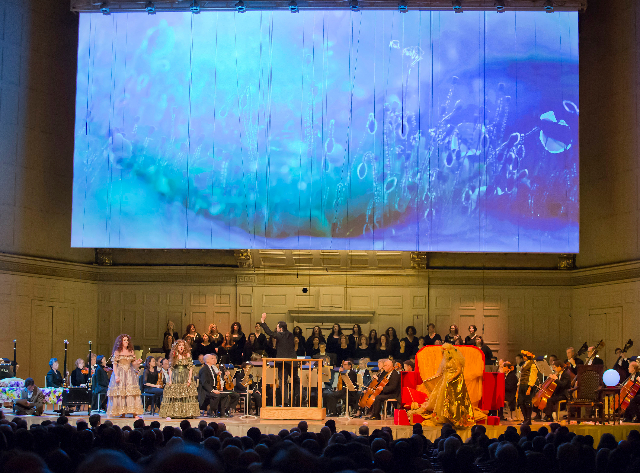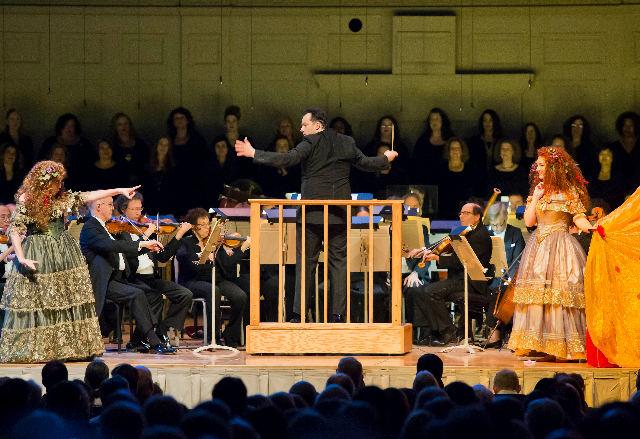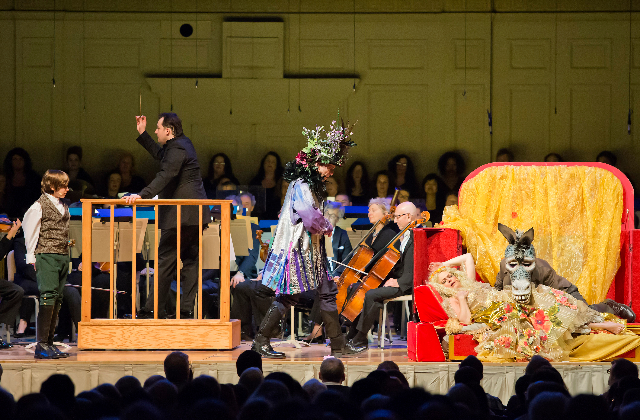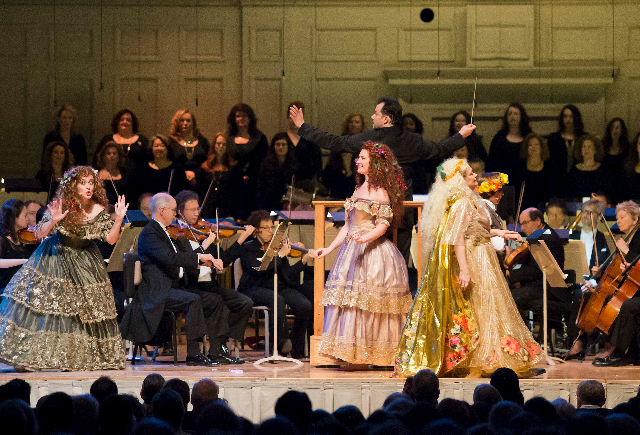Boston Symphony Shakespeare Festival
Three Concert Program Features Vocal Music, New Works
By: David Bonetti - Feb 17, 2016
Boston Symphony Orchestra Shakespeare Festival
Symphony Hall, Boston
January 28 through February 13
Andris Nelsons, conductor
Carl Maria von Weber: Overture to “Oberon”
Hans Werner Henze: Symphony No. 8
Felix Mendelssohn: Overture and Incidental Music to “A Midsummer Night’s Dream”
In the Mendelssohn:
Amanda Forsythe, soprano
Abigail Fischer, mezzo-soprano}
In non-singing roles: Karen MacDonald (Titania), Carson Elrod (Puck, Mendelssohn), Antonio Weissinger (Boy, Young Mendelssohn), Will Lyman (Oberon)
Bill Barclay, adaptation and stage direction
Kathleen Doyle, costume designer
Cristina Todesco, set designer}
Hillary Leben, video artist
Women of the Tanglewood Festival Chorus, William Cutter, conductor
Jan. 28, 29, 30 & Feb. 2
Dmitri Shostakovich: Excerpts from Incidental Music to “Hamlet”
Hans Abrahamsen: “let me tell you,” for soprano and orchestra, text by Paul Griffiths, Barbara Hannigan, soprano soloist
Sergei Prokofiev: Excerpts from the Ballet “Romeo and Juliet”
Feb. 4, 5 & 6
Shakespeare and music go together like ham and cheese, love and marriage (and a horse and carriage) and, in opera terms, “Cav” and “Pag.” Especially since his rediscovery and re-appreciation in the 19th century, Shakespeare’s plays and sonnets have been adapted for operas, ballets, songs, orchestral music of all sorts and popular musicals like “Kiss Me Kate” and “West Side Story.” According to the BSO program booklet, a 1991 reckoning listed some 21,362 pieces of music inspired to one degree or another by the Bard. Since the BSO’s own mini-Shakespeare festival includes at least three major works written since then, we can legitimately deduce that the number has increased significantly in the past quarter century.
So, what’s the appeal? The works of that enigma from Stratford-on- Avon are universally judged to be in themselves “musical” enough in nature that they would seem to stifle any additional musical thoughts, rather risk gilding the lily. But the opposite seems to be true. That’s probably because, stripped of their poetry, the plays offer great stories - stories of love and lust, death and revenge, hubris, ambition, political intrigue and gut-busting comedy. And his poetry and songs often ask to be set to music. Even if they merely spoke in prose, like Moliere’s bourgeois gentleman, the larger than life characters that fill his plays would demand musical attention. Lear’s rages, Hamlet’s indecisiveness, Othello’s jealousy, Macbeth and his Lady’s ruthless ambition, Falstaff’s lust for life, Romeo and Juliet’s hopeless love all call out to composers to add something to their timeless, even archetypal, stories.
Now, on the 400th anniversary of the poet’s death, the BSO is acknowledging his profound influence on music. It is not programming any of the operas his works have inspired – Symphony Hall is not, alas, the proper space for that - although it co-presented at Sanders Theatre in Cambridge the Boston Youth Symphony Orchestra’s semi-staged production of Verdi’s “Otello,” arguably the greatest operatic adaptation of one of his plays (and better than the original I would be brazen enough to suggest) as part of its “Insights” program. (I am embarrassed to say that I did not attend that performance.)
The under-publicized “Insights” program aimed to expand the mini-festival beyond orchestral music. In addition to its single opera presentation, it featured two chamber music concerts, one of which I did attend (music by Strauss, Stravinsky, Ned Rorem, Beethoven and Korngold), lectures and a pair of “conversations with the composers.” A nice range of programs, but it would have been nice if the BSO had partnered with a local professional opera or ballet company to present a fully staged production of one of the many music-theater works inspired by Shakespeare. If it were ever to attempt another such mini-festival, such collaboration would be welcome. It would take planning several years ahead, of course, and one gets the impression that the BSO’s Shakespeare festival is an idea new music director Andris Nelsons pulled together in relatively short order. If that’s true, then the entire organization deserves a hand: it came off as if it had been planned for many years.
The two of three symphonic concerts I attended featured vocal music with soloists, Amanda Forsythe in Mendelssohn and Barbara Hannigan in Hans Abrahamsen, who set a singing standard that will be hard to surpass the rest of the season. (The third program, which included music by Strauss, Dvorak, Tchaikovsky and a world premiere by George Tsontakis, was purely orchestral in nature.)
Both concerts, led by Maestro Nelsons, were largely satisfying, although not all the music was of equal merit or equally well played. But in both, the vocal components of the evening were the highlights, and I’m not just writing that as a lover of vocal music – the long, and ecstatic ovations for both pieces demonstrated that the audience largely agreed with me.
The first concert featured three works based on “A Midsummer Night’s Dream.” It opened with music by Carl Maria von Weber and Hans Werner Henze but was dominated after intermission by a semi-staged production of Mendelssohn’s “Overture and Incidental Music” to the same work. Although both Boston Baroque and the Boston Early Music Festival have shown how singers and instrumentalists can cohabit the same space collegially, they have the benefit of small orchestras. It’s harder when a full-scaled romantic-era orchestra has to share its already crowded stage with sets and singing actors. It can work. (Part of the trick is costuming.) In the 1980s, Seiji Ozawa led a brilliant semi-staged production of Alban Berg’s “Wozzeck” in Symphony Hall on a tiny stage erected above the orchestra.
Mendelssohn’s music for “A Midsummer Night’s Dream” exists, alas, in the category of wallpaper music for those who listen to top-40 classical radio stations like Boston’s WCRB. My doubts about the BSO’s promised semi-staging and my general lack of interest in the music did not lead me to expect much. But, boy, was I wrong, proving once again it is always necessary to test one’s prejudices.
And it is always necessary to hear even the most familiar music live once in a while. From the first notes, I heard the music as if for the first time. Under Nelsons’s baton, the overture, written when the Mendelssohn was only 17, was precociously sweet and light, but warm, even soulful. Nelsons painted a marvelous evocation of a forest in which fairies romp among mortals of several ranks and the gods themselves. Nelsons drew out the final statement of the main theme to the point of it almost breaking, leading the dream into the main body of the work, which, apparently seamlessly, Mendelssohn wrote 16 years later at the request of King Friedrich Wilhelm IV.
The “staging” was very simple: a desk, stage right, a bed, stage left. Projections of vintage images on a backdrop above the orchestra helped create a sense of period and place. Images of the score and of letters Mendelssohn wrote to his beloved sister Fanny connected with a light hand to the actor playing Mendelssohn writing at the desk below.
The potential for trouble starts when the music stops. This is one of those problematic hybrid works that were popular in the 19th century (and have endured in contemporary Broadway-style musicals). We know the overture and incidental music from recordings and performances, but the full work includes great gobs of spoken text from the play as well as text spoken to music, “melodrama” in its original sense. It is extremely difficult to make such hybrids work for the contemporary audience. The entire thing is far too long but cutting it risks making it a dramatic mish-mash.
The BSO production team, led by Bill Barclay, the music director of Shakespeare’s Globe Theatre in London, saw the problems ahead of time and headed them off at the pass. The actors were miked, cuts were made and the old-fashioned nature of the hybrid beast was acknowledged in the first spoken scene, when Carson Elrod (excellent), as Mendelssohn, gets up from his desk, flips through the written text of the play, dismissing them with “Words, words, words,” until he comes to a part he likes. OK, time to relax: this was going to work.
For the rest of the hour-long piece, orchestral and sung music, spoken word and action, often spilling out into the audience, flowed almost seamlessly. Kathleen Doyle’s costumes and wigs were extravagant, making one forget that one was watching a semi-staging. Hillary Leben’s video projections and the lighting design combined to create a nicely atmospheric forest.
Of course, among the actors there had to be a ham. Local Shakespearean Will Lyman, who played Oberon, looked fabulous in the modern primitive drag and leafy crown Doyle created for him, but he seemed so in love with playing Shakespeare that you couldn’t hear him, even miked. But Karen MacDonald, a blowsy Titania in a billowing blonde wig, spoke her lines with delightful naughtiness. One can only imagine what her plans for the changeling boy she and Oberon fight over might include. The Boy, Antonio Weissinger, was charming.
But of course, we are an opera critic, and we came to hear the singing. True, there isn’t much of it, but what there was did not disappoint. Boston’s reigning early music diva, soprano Amanda Forsythe, who recently released a solo recording of Handel arias with Cleveland’s Apollo’s Fire, revealed herself to be an extraordinary singer of Romantic music that favors her light but expressive voice. One of the fairies in Titania’s court, she appeared on stage in a full green gown and a red wig that billowed out as extravagantly as Titania’s. At first I didn’t recognize her, but when she sang she was instantly identifiable. She and mezzo-soprano Abigail Fischer (fine) serenade the recumbent Titania with a lullaby of exquisite Mendelssohnian sweetness – pure bliss.
One of the frustrations of the Boston music world is that Forsythe is pigeonholed here as a Baroque specialist. It is true that she has a particular sympathy for 18th century music and has developed an apparently natural ability to ornament her arias with thrilling coloratura, but in her international career, she is also known as a Rossini singer, and she even sang Verdi (Nanetta in his “Falstaff”) at Covent Garden. And she also sings new music. Would that some local music organization would wake up to what a wide-ranging talent we have in our midst. Kudos to the BSO for giving her the chance to sing something we don’t expect of her.
The incidental music continues to the inevitable “Wedding March,” which is instantly recognizable to even those who never heard of Mendelssohn or listen to even Top-40 classical music – they might have walked down the aisle to it. But first there is a brief but time-stopping “Nocturne,” which paints a picture of the forest that points the way to Wagner’s great orchestral passages. Nelsons brought an extraordinary sensitivity to the movement, highlighting the horns, which evoke the forest depths. And Nelsons played the “Wedding March” brassy and rustic, which is appropriate to the setting, as the Boy, holding a blue globe, led Titania and Oberon up the aisle and through the audience.
A couple of more scenes set to music come before the rapturous conclusion, which featured again the vocal soloists and the women of the Tanglewood Festival Chorus, excellent as usual. It left the entire audience, well, enraptured.
The concert opened with Carl Maria von Weber’s “Overture to ‘Oberon’,” the only part of his opera based on Shakespeare (actually an adaptation of Shakespeare) that has held a place in the repertory, mostly in Pops concerts. It’s a rousing piece of music that reminds you that there is something to German Romantic opera before Wagner, especially in its rich orchestrations. You can hear the twinkle of the fairy dances, especially if you know beforehand what the subject of the opera is. Nelsons seemed to enjoy playing the little piece, which he probably grew up hearing in Riga.
Hans Werner Henze’s Symphony No. 8, which followed was more substantial. Commissioned by the BSO in 1993, it is an abstract piece of music without any implied scenario, so you would be correct if you heard it purely as a piece of music with no extra-musical content. But Henze divulged in a letter to Seiji Ozawa, who led the premiere, that he was thinking of Shakespeare’s “Midsummer Night’s Dream” when he wrote it, so you can look for clues if you’re so inclined.
The three-movement work opens with gurgling sounds in the strings punctuated by emphatic brasses. The work is full of color, exploiting every instrument in the orchestra. We hear the tuba, the trombone, the vibraphone, the triangle, the piccolo, the snare drum, the harp when they help define otherwise dimly noted moments from the play. Henze was both a twelve-tone composer and a writer of opera, and, even though the gurgling sounds of the opening continue through the piece, the symphony is more reminiscent of Berg’s “Wozzeck” than of Mendelssohn. The second movement features tubas making honking sounds, evoking the play’s rustics, and the final movement features the shimmering sounds of a morning in the forest. The symphony is a pleasant enough exercise in tone color, but it leaves little to think about later.
The second concert was a mixed bill, the first two pieces based on “Hamlet,” and the last on “Romeo and Juliet.” The two outer pieces featured the two great composers of the Soviet era, Dmitri Shostakovich and Sergei Prokofiev, both greatly championed here during the Koussevitsky era. In programming Shostakovich’s “Excerpts from Incidental Music to ‘Hamlet’,” Nelsons got to hit two birds with one stone – celebrate Shakespeare but also add another notch in his belt of playing and recording music Shostakovich wrote “Under Stalin’s Shadow.” (This just in: the BSO won a Grammy for the first recording in the series, which featured the Symphony No. 10.)
Between them, the local premiere of Danish composer Hans Abrahamsen’s “let me tell you,” a song cycle based solely on the words of Ophelia, was the central work in every sense of the word. At its conclusion, more than a few audience members clapped til their hands were red and stinging and shouted til their throats were hoarse.
But first the two Soviets.
There are a lot of people who think that all of Shostakovich’s music is meretricious (there are those who think the same of Mahler). I don’t (in either case), but it is true that Shostakovich wrote a lot of dreck for the Soviet state. His incidental music to “Hamlet” is not, however, an example of that. It was written for a thinly veiled anti-Stalinist production of the play directed by the avant-garde director Nikolai Akimov in 1932. Shostakovich arranged music from the production into a suite, which Nelsons conducted here, and later composed another score based on “Hamlet” for the brilliant film by the great Soviet director Grigori Koznitsev. (I saw it in the late ‘60s and some scenes still stick in my memory.)
All that said, the music Shostakovich composed for the 1932 suite is meretricious. The complete suite includes 13 movements; Nelsons programmed only seven, as if he couldn’t bear to conduct the whole thing. It opens with a passage of total bombast in the Soviet style that Shostakovich’s celebrated irony does little to mitigate, and there’s a stately funeral march in a mock-fascist style. There is a lovely, lyrical movement titled “Ophelia’s Song,” which seems out of place, and the piece ends with a Requiem that is, as expected, pompous and empty. (Kurt Weill played this game with greater subtlety and more fun during his Weimar years.) The BSO never played any music from the suite before, but Arthur Fiedler played – and recorded - the entire thing with the Pops. Go figure.
The concert concluded somewhat anti-climactically with excerpts from Prokofiev’s ballet “Romeo and Juliet,” one of the great ballet scores of the 20th century, so good that you can sit and listen to it without having to see bodies in motion. (Try that with Minkus!) Nelsons conducted with familiarity – he was born in 1978 in Soviet Latvia. He nailed the Soviet gymnastic style of the opening “Morning Dance,” heavy on the percussion. (This is not my preferred way to greet the day.) And he brought out the sweet lyricism of the movements associated with Juliet. The “Balcony Scene” is one of deep passion, the music for the pas de deux seeming to melt two bodies into one, and Nelsons attended every detail with care and attention, bringing forward the astringency that balances the sweetness, forecasting the tragic fate of the two lovers. In the movement, “Romeo and Juliet Before Parting,” he underscored the profound sadness of the music, emphasizing the great upwelling of feeling in the strings.
The disappointment for me was in “Montagues and Capulets,” a scene of street fighting between the two hostile clans. A triumph of the Soviet industrial style, intentionally crude and bombastic, intended to confront head-on the dainty bourgeois music of the decadent West, it should knock you out of your seats with its savagery. That’s at least how it affected me when I heard Yuri Temirkanov conduct his orchestra - the Leningrad or St. Petersburg Philharmonic (I can’t remember if it had been renamed yet) - at the Théâtre des Champs Elysée in Paris shortly after the “fall” of the Soviet Union. (And who’s laughing now?) It was an unseasonally hot and steamy night and even the proper French men took off their jackets and loosened their ties. The music was like a blast from a Utopia that died a-borning. The Parisian bougeoisie roused from their torpor to applaud with a ferocity that matched the music. Nelsons, alas, did not even come close.
The best comes last. It’s always risky to lavish excessive praise (or damnation) on a new work in any genre. How many newly minted “masterpieces” are quickly revealed to be mere sensations and then forgotten within a few years? But I think it is safe to say that Hans Abrahamsen’s “let me tell you” is a masterpiece, an extended vocal work that sounds like nothing you’ve ever heard before, weird and rapturous, strangely ecstatic and deeply nihilistic.
It is the story of Ophelia, the innocent girl Hamlet toys with, told in her own words rearranged and turned into a poem that could have been written by Samuel Beckett, its final lines: “I will give up this and go on./I will go on.” (The strong association with Beckett might be both its strength and, in the long run, its weakness.) Paul Griffiths’s novel, “let me tell you,” which I have not read, is one of those modernist – or is it post-modernist? – literary conceits in which a minor/major character is elevated to center stage. Tom Stoppard’s “Rosencrantz and Guildenstern Are Dead” and Jean Rhys’s “Wide Saragasso Sea,” in which the story of Bertha, the original madwoman in the attic from “Jane Eyre,” is told, are precedents. Ophelia spoke only some 480 words, not much, but enough for Griffiths to write a 130-page novel.
The genesis of the work involved several players. Griffith’s wife approached the soprano Barbara Hannigan to help commission a composition based on “let me tell you” as a surprise birthday gift. Although he had never written for the voice before, the Dane Hans Abrahamsen quickly became the composer of choice, and Hannigan, who has a working relationship with the Berlin Philharmonic, enlisted it to commission the work. Andris Nelsons gave its premiere in Berlin in 2013. It was immediately taken up, recorded in Munich, given its American premiere just last month in Cleveland by the Cleveland Orchestra, which then played it at Carnegie Hall in New York and thence to Boston under its original conductor with his new orchestra, the BSO. New works of music rarely move so fast these days. Most audiences can wait – for years, for ever – to hear new works of music in the “classical” tradition.
But this is different. It is engaging, emotionally compelling and sonically beautiful. Hannigan, a specialist in modern music – she has given the premieres of more than 80 works – is the ideal person to deliver it. Indeed, with its vocal demands, it’s hard to think of any other singer who could deliver it.
Abrahamsen uses a large orchestra but sparingly. His orchestrations are pointillist – a sound here from the harp, another here from the bassoon, another here from the vibraphone, another here from the timpani, the strings playing a major role but never dominating as they do in almost every other orchestral work you’ve ever heard. It is quiet, sensitive to the anguished feelings of its soprano soloist who sings the most melancholic words in literature – or at least Griffiths and Hannigan make you feel that way about them. In the second part, as Hannigan sings, ”You have made me like glass -/ like glass in an ecstasy from your light./ Like glass in which light rained/and rained and rained and goes on,/like glass in which there are showers of light,/light that cannot end,” the orchestra creates that image through sound – tinkling, twinkling, shimmering, music box-like sound.
The 35-minute piece is in three parts. The first is about time and memory, the second about love, and the third about a “snow landscape” in Abrahamsen’s words. In addition to Beckett, it also makes you think of Schubert’s “Winterreise” (The Winter Journey), the bleakest song cycle in the literature.
But Hannigan, whose vocal skills are astonishing – lustrous tonality with pinpoint precision hitting impossibly placed notes – makes the whole thing ecstatic. Hers was enraptured singing, fully embodied and fully mindful. Her art trivializes mere praise. She brought us through the mirror into truth itself.
I kick myself for not going back to hear the two subsequent performances. One can only hope that the BSO reschedules the work and brings Hannigan back soon and often.






